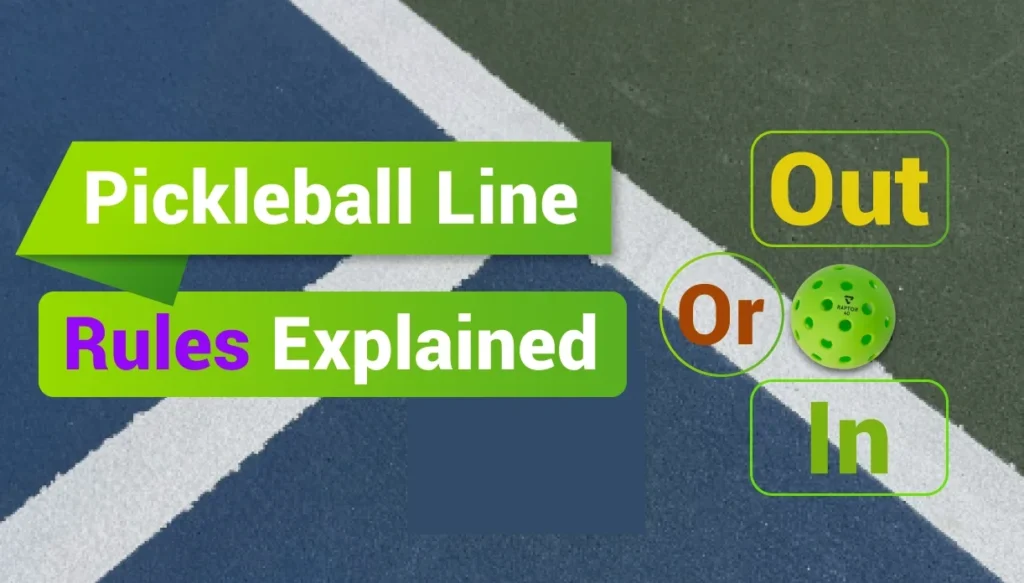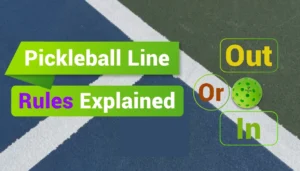I’ll never forget the first time I called a ball “out”… and then immediately got the look. You know the one — half confusion, half “are you serious right now?”
My partner froze, our opponents paused, and I realized I had no clue what line the ball actually hit. Spoiler: I was wrong. Very wrong.
Let’s be honest — pickleball line rules can feel like a mystery, especially when the ball is zipping around faster than your grandma’s stories about “back in her day.” And hey, no shame in that! We’ve all been there.
But here’s the deal: knowing your line rules doesn’t just save you from awkward court standoffs — it actually makes the game way more fun.
Whether it’s serves, volleys, or those hair-splitting baseline shots, this guide is here to help you call every ball with confidence.
And no, you don’t need a law degree or a magnifying glass to figure it out. We’ll break it down clearly, throw in some laughs, and make sure you walk away knowing when a ball’s in, out, or “just let it go.”
So grab your paddle and let’s dive in — because the only thing worse than a bad line call… is being that player who argues it for 10 minutes.
Know Your Boundaries: Pickleball Court Lines Explained
Alright, first things first—let’s get cozy with the court itself. Imagine a quick aerial view of the court in front of you. Here’s what each line means:
- Baseline: This is the line at the very back of each side of the court. Think of it as home base. In or out, we’ll get to that in a second.
- Sidelines: These run along the length of the court. If you’re playing doubles, these are your outer boundaries.
- Centerline: Splits the service area into left and right, and yes, it matters during serves.
- Kitchen Line: Also called the Non-Volley Zone line, this is right in front of the net. And, yes, the kitchen line has some of the trickiest rules!
But don’t worry, I’ve got you covered on each one.
Title: Pickleball Court Line Rules
So, What’s “In” and What’s “Out”?
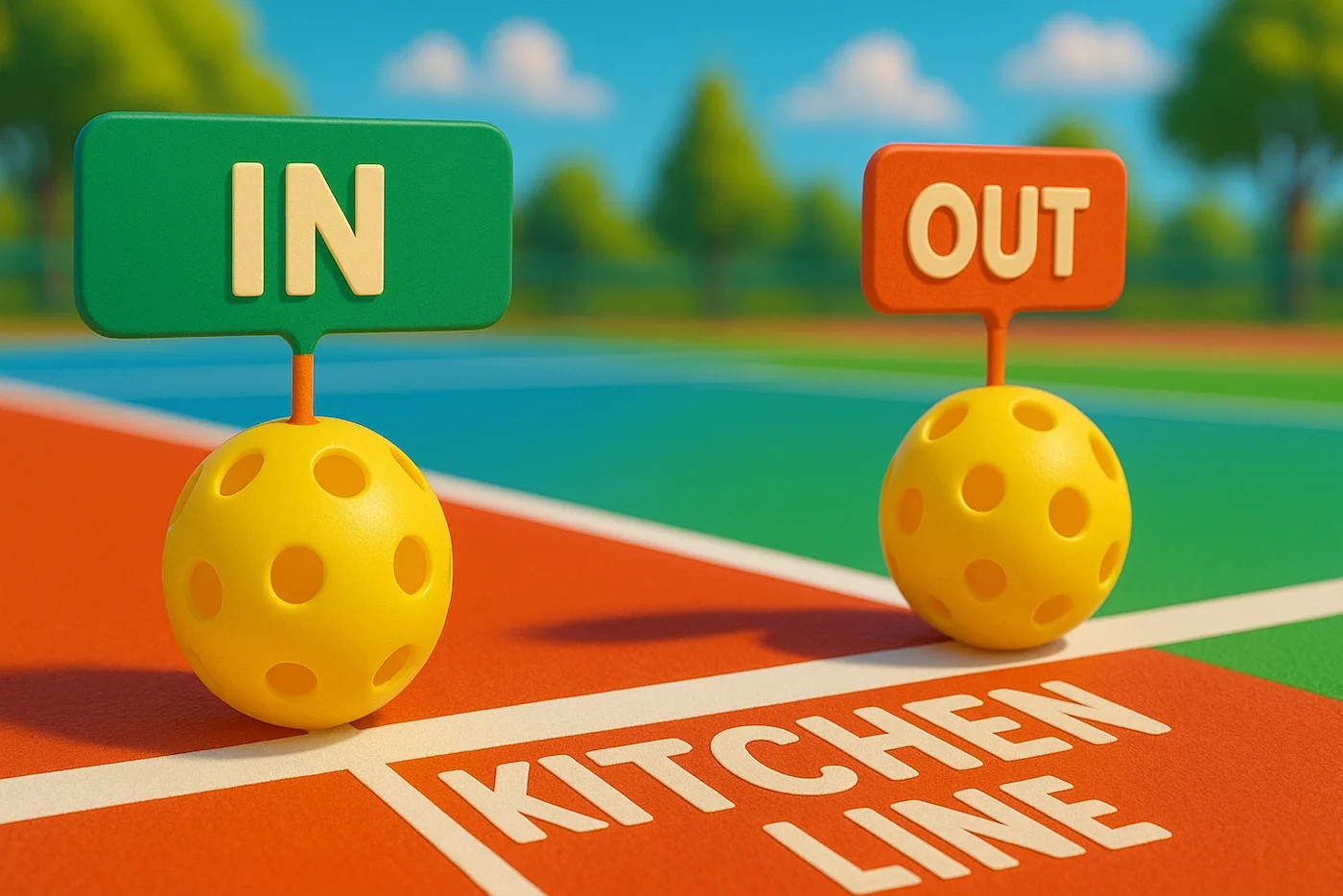
Here’s the golden rule I swear by: if the ball touches any part of the line, it’s in. Yes, even just a hair on the paint means the ball is still in play! Let’s break it down by what’s happening on the court:
- Serving: When you’re serving, you need the ball to land diagonally in the opposite service area. The trick here is that your serve can’t hit the kitchen line! If it does, that’s considered out, and you’ll have to pass the serve to your opponent.
- During Play (Rallies): Once you’re in a rally, things get simpler. Any line the ball touches is fair game—even the kitchen line! So if your shot skims that line, it’s good.
Remember, those lines act like your boundaries, like fences on the court. If the ball is touching even a teeny bit of that line, it’s counted as in.
The “Hover” Issue: No, It Doesn’t Count as In!
This is where pickleball gets unique! Ever notice that when the ball lands, it doesn’t squish down like a tennis ball? That’s because pickleballs don’t compress—they’re solid little guys.
So if the ball is hovering over the line but doesn’t actually make contact with the paint, it’s out.
Quick tip: You want to look for a visible gap between the line and the ball. If you see that, it’s out. If the ball’s kissing the paint, it’s in. Easy, right?
Kitchen Rules: Watch Your Step!
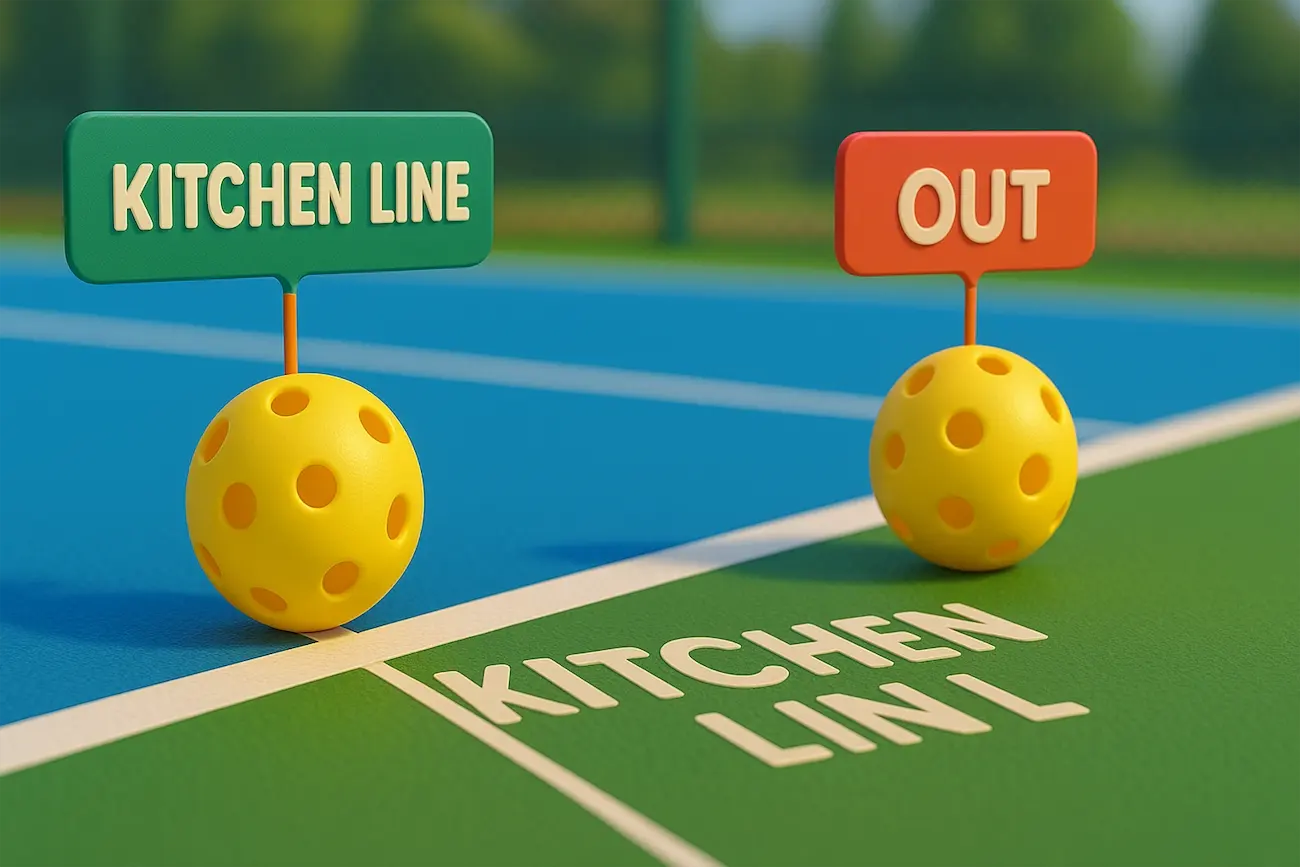
The kitchen (or Non-Volley Zone) is a hot spot on the court. Here’s what you need to know about this special area:
- On the Serve: The ball cannot land in the kitchen or even touch the kitchen line. That means the entire kitchen area is out of bounds for serves.
- During the Game: When you’re volleying (hitting the ball in the air), you can’t have a foot on or inside the kitchen line. If you do, that’s a fault. But during rallies, if the ball lands on the kitchen line, that’s considered in. Keep your feet out and you’re golden!
Curious how these kitchen rules play out in different settings? Check out how indoor environments can slightly affect court positioning and rule enforcement — especially when you’re playing under a roof.
Who Calls the Shots? Deciding In or Out on the Court
Let’s talk about who actually makes these calls. In pickleball, it’s an honor system. So, if the ball lands on your side of the court, you and your partner are responsible for calling it in or out. And that includes shots near the baseline or sidelines!
For doubles: Whoever has the best view makes the call. For example, if a ball is coming toward your baseline, it’s usually easier for your partner to call it since they can see the whole shot from a better angle.
And here’s a simple rule of thumb: When in doubt, call it in. Give your opponent the benefit of the doubt, and everyone keeps smiling.
Still Confusing: A Real-Life Pickleball Line Rules Example
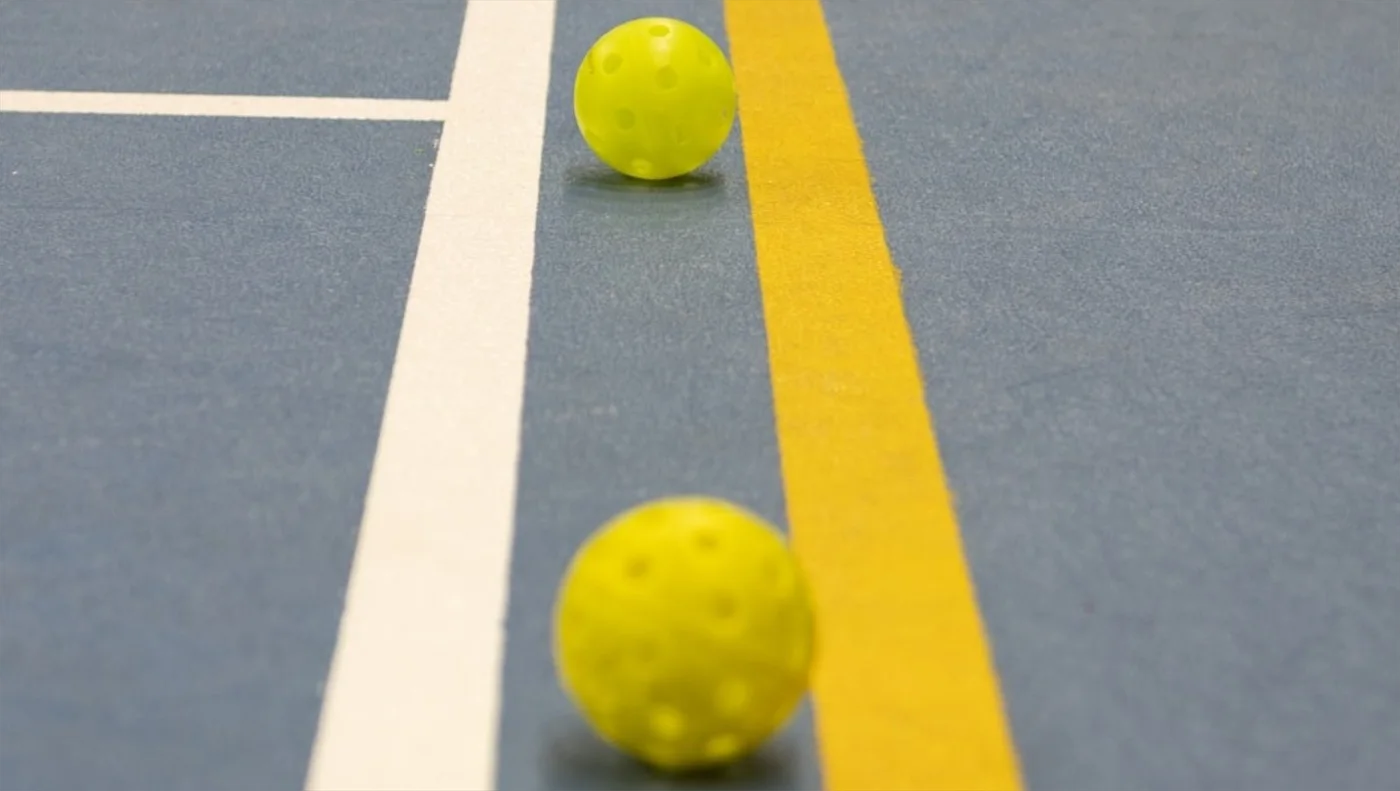
Imagine you’re in the middle of a close doubles game, and you’re receiving a serve. The score is tied, and every point counts.
Here’s how a few different line call situations might play out:
Situation 1: The Serve Skims the Kitchen Line
The opposing team serves the ball, and it lands just inches away from the kitchen line on your side. You’re watching closely and notice that the ball barely skims the kitchen line before bouncing out of the service area.
Since the serve cannot touch the kitchen line, this is an automatic fault, and you call “out.” Your opponents accept the call, and now your team has the serve.
Situation 2: A Rally Shot that Barely Touches the Sideline
A few rallies later, you find yourself near the baseline, returning a high shot from the opponents. You hit a soft shot that drops down close to their sideline. Both teams watch as the ball lands, and it’s really close.
One opponent calls “out” right away, but the other player hesitates, thinking it might have actually touched the line. After a quick chat, they decide to call it in because of the “benefit of the doubt” rule.
If there’s any doubt about whether the ball touched the line, it’s considered in. Point to your team!
Situation 3: “Hovering” Near the Kitchen Line
During another rally, you’re both dinking close to the net. You notice that one of your opponents reaches forward for a shot, and their paddle crosses the kitchen line to volley it. However, it’s a close call—you aren’t sure if they also stepped on the kitchen line.
In the heat of the moment, you don’t make an immediate call. After the point ends, you bring it up. Since the play wasn’t stopped for a fault right then, the point stands.
This is a great reminder that line calls—especially around the kitchen—need to be called immediately!
Situation 4: A Shot Heading Out, But You Hit It Anyway
The opponent smashes a shot toward your baseline, and it’s coming in hot. You see it sailing long, but by instinct, you reach out and hit it before it bounces. Just as you do, you realize it would’ve gone out!
Since you hit it before it bounced, the ball is still in play. Unfortunately, this means the shot is counted, and you miss out on a possible “out” call. Lesson learned—sometimes it’s best to let that ball go!
Situation 5: Disagreeing on a Call with Your Partner
In the final, deciding point, your opponents hit a low shot that lands right near your baseline. Your partner calls “out” as you reach to return it, but you thought you saw it hit the line.
After a quick discussion, you decide to give the benefit of the doubt to your opponents and call it in. They win the game by one point, but you walk away knowing you made the fair call.
Pro Tips for Making Better Line Calls
Want to be the line-call champ? Here are a few tricks I’ve picked up:
- Look for Paint Behind the Ball: If you see paint, the ball is out. This little trick has helped me make so many more accurate calls.
- Get in Position: I try to keep my eyes on the lines when I’m close to the baseline or kitchen. It really helps when it comes to those super close shots.
- Practice Makes Perfect: I love doing line call drills with friends. It’s fun, and it trains my eye for those close calls in real games.
Stay Fair, Have Fun, and Let’s Play!
And that’s a wrap! Hopefully, these tips help you make confident line calls and keep the game friendly and fair. I’ve learned that when we all follow these rules, it makes pickleball that much more enjoyable.
So next time you’re on the court, try out some of these tips, call it like you see Since the serve cannot touch the kitchen line, this is an automatic fault, and you call “out.” Your opponents accept the call, and now your team has the serve.
Top 10 Pickleball Line Call FAQs
What’s the basic rule for whether a ball is “in” or “out” in pickleball?
If any part of the ball touches the line, the ball is considered in. If the ball lands completely outside the line, it’s out. Simple as that!
Who is responsible for making line calls during recreational games?
In recreational play, each team calls the lines on their own side of the court. It’s based on the honor system — always call it fairly!
What should I do if I’m unsure whether a ball was in or out?
According to the official rules, if there’s any doubt, the benefit goes to the opponent. So if you’re unsure, you should call the ball in.
Can my paddle, hand, or body help me decide if the ball was in?
You can use any part of your senses to judge the ball — including feel and sound — but line calls must be based on what you see. No guessing!
What happens if players on the same team disagree about a line call?
If one player sees the ball in, and the other isn’t sure or thinks it might be out, the call defaults to “in” — again, doubt favors the opponent.
Are players allowed to question or overturn their opponent’s line calls?
Nope — you can’t overrule your opponent’s call on their side of the court. You can politely ask for clarification, but the final decision is theirs.
What if the ball hits the line during the serve?
If the serve lands on the baseline or sidelines, it’s in.
BUT: if the serve touches the kitchen (non-volley zone) line, it’s a fault. That’s one exception to remember!
Can spectators or players not in the rally make line calls?
No. Only the players in the rally may make line calls. Referees can overrule in tournament play, but in casual games, outside opinions don’t count.
Are line calls different in tournament play?
Yes — in tournaments with referees, referees can make or overrule line calls, especially if they have a clear view. Otherwise, player calls still stand unless challenged or appealed.
What’s the best way to improve my accuracy with line calls?
Practice, stay focused, and develop good court positioning so you have the best view of where the ball lands. Also, stay calm — no need to rush the call. With time, your eyes (and confidence) get sharper!

